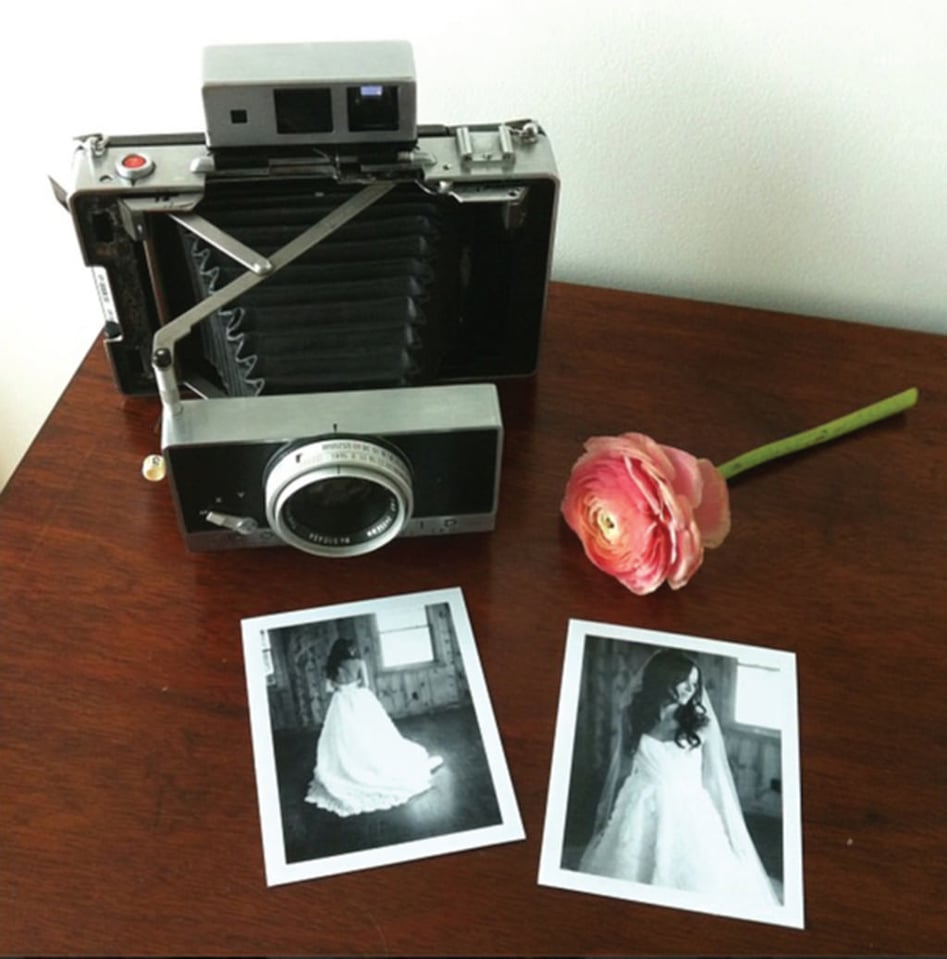At the beginning of 2012, I knew I wanted to buy a Polaroid camera. There is something so irresistibly fun about taking a photograph and having the print in front of you instantaneously. I considered several options but ultimately decided on the Polaroid 180 Land Camera with a 114mm Tominon Lens.
For my first Polaroid camera I wanted something old—not one of the new Fuji Instax Camera (although, I think I might have an Instax purchase in my near future too! I am hooked on instant cameras right now!).

Initial Impressions + Specs
After having used this camera for a year, the Polaroid 180 is the perfect camera for me. You can set the exposure manually (selecting the aperture and shutter speed independently), which was an important factor when looking for an instant camera. And, it is decent in low light because the aperture ranges from f90 to f4.5 with 18 click stops. The shutter speeds run from 1s to 1/500 with Bulb.
I attached an OpTech strap to mine, since it did not come with one (you can see the strap in the product photos above).
I also enjoy the fact that this camera folds up and isn’t TOO large to carry around. When closed with its case, the dimensions are 2.5-inch depth x 8-inch width x 4.5 inch high. When open, the camera measures 7-inch depth x 8-inch width x 4.5 inch high.
The Film
Fuji makes 2 film stocks that fit the Polaroid 180 which can be ordered new from B&H:
- FP-3000B Professional Instant Black & White Film (10 Exposures) $9.49
- FP-100C Professional Instant Color Film ISO 100 (10 Exposure, Glossy) $8.09
This is 3¼×4¼” instant peel-apart instant film. When you peel it apart you are left with your image and the negative. The Polaroid version of this film is expired, not in production, expensive, and hard to find, which is why I think the new Fuji version is the way to go.
My favorite film to shoot the Fuji FB-3000B (the black and white version). I like it because it is great indoors or on cloudy days, and I love the classic look of black and white. I scan my images from the Polaroid 180 on a Canon MX882 Printer/Flatbed Scanner and I often desaturate the scan a little bit in Photoshop.

The black and white film also produces a negative that can be used as-is. The negative from the color film must be bleached before you can use it (which I have never tried). The right image below was produced by scanning the negative from a Fuji FP-3000B photo and inverting in Photoshop. In order to have a usable negative, be sure to let the emulsion sit for 1.5 minutes before pulling apart.


The Focusing
This camera uses a rangefinder method of focusing. That means that when you look through the viewfinder, you can see a second, smaller image of your scene. To get your shot in focus you must move the focusing lever until the two images line up. The smaller image of the scene is quite small, and sometimes it is hard for me to see if it is correctly matched up. I do get quite a few photos not completely in focus due to this.

Battery
One of my favorite parts about this camera is that no battery is required!
Where to Buy
These cameras are no longer sold new on any local shops or online retailers. But you can find one on sites like eBay and Craigslist … I bought mine used off a photographer on Facebook for $230.
Polaroid 180 Land Camera
- Optical Performance
- Features
- Build Quality
- Handling
- Value
- Size and Weight
Photography Life Overall Rating





Hi, Can someone explain to me how it is possible that the camera does not use batteries…
Hi Nathaly,
Cameras in my time (late 70’s and 80’s had no batteries at all, as they were mechanical wind ons. Film came in canisters and were wound on to the spouls inside the camera. Following physical, mechanical focussing using the external lense, the appeture opened and light fell on to the film before staining it. Following the depression of the trigger button, the film was physically wound on using your finger. A flash could be added to some cameras using a fitting on the camera body. The first I used in 1978 was a physical wind up copper wire system inside a metal charge canister. This was just enough voltage to send to a mercury ignition that flashed (ignited) on push of camera trigger button – appeture opened at same time taking the flashed light onto the film. No batteries required at all.
It’s too bad that these films are currently running about 4x the prices mentioned above. I’m hoping it’s just due to a shortage. The current prices are just too high to experiment with.
Hi I have got a Polaroid 180 camera complete with the box and holder and even the filter kit and all its books it was my grandad a before he passed away and I am
After selling it if anybody can help me or would be interest please get back to me asap:)
Today I sold my complete collection of Polaroid cameras and accessories. Not a big collection. In it was a 180, a 195, a pair of 360s, their last Reported and a number of others. I used the 180 and 195 extensively for years on field trips with b&w pos/neg in one ans color in the other. Spent days and weeks in the southern Everglades with them. Along with a Weston Ranger meter, grey card, cable release, tripod and small translucent plastic container for pre-exposing. A bit of a bulky system but seeing the first print with the etching that made the print seem almost 3 dimensional sold me.
When I taught potography classes, I had student use the cameras so, they could immediately see the results and figure out what went right or wrong. Also, taught them 1 great result is better that 36 chances. Slowed them down a lot. A number of them after the class bought the 195 or 180 and it their main camera.
Great article on the Polaroid 180. I’m looking for a 180 myself, I have a 250, but want the control of the 180. A question, you mention that to have a usable negative, let the emulsion sit for 1.5 minutes, do you mean that you should let the image develop well beyond the 15-20 seconds recommended by fuji, and not peel the print and negative apart until 1.5 minutes have passed?
cheers.
You know, when CDs first came out, you could hear the overall higher frequency; that tinny sound, though crystal clear and all. And for a long time, I still enjoyed the sound of a good, strong cassette instead. Well, it’s kind of like that with regard to photos taken by black and white film cameras compared to black and white photos taken by digital cameras. The look of real black and white is just somehow something deeper and more intimate than digital black and white, at least of what digital black and white photos I’ve seen so far (i’m pretty new to photography).
I was looking at some of the black and white works fo John Free and other street photographers. Man, there’s nothing like black and white film when these guys shoot. Those “old” cameras are still very important and special in the world of photography. Nothing like them, as I’ve seen, matches what they produce. It’s not an issue of black and white film being “better”; it’s film black and white is its own species and produces its own unique creation.
I have a Polaroid 180 Land Camera that I might sell. It belonged to a family member and I have never used it. The original case and many/all? of the original accessories are included – some of the lenses are still in their plastic wrappers. Can someone suggest the best way to sell this? Thank you.
Nice and working well Polaroid 180 Land Camera kit for sale here:
www.auction2000.se/auk/w…Lp.twitter
The “WestLicht” camera auction in vienna will offer my unike Polaroid 180 set on 23nd November 2013. Online bidders welcome. Get this phantastic lovely piece of camera for you!
www.westlicht-auction.com
I am not sure what you mean by saying you desaturated the b&w photos. They are already fully desaturated, possibly you meant lowering the contrast or something because otherwise it makes no sense. From a quick inspection of the sample above that you didn’t “desaturate” I notice that the scan has a little too much blue, but this is just because you didn’t scan correctly.
You got a good deal because the 180 routinely sells on eBay for $450-$550